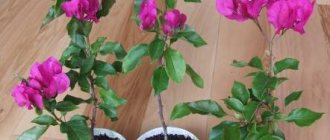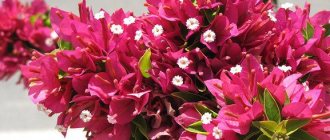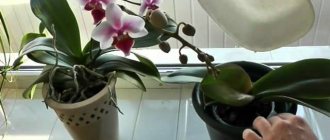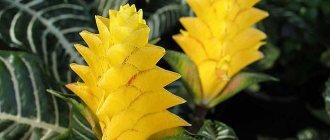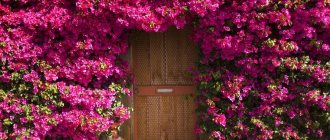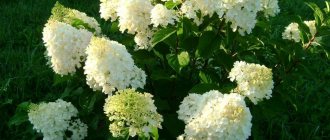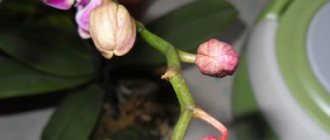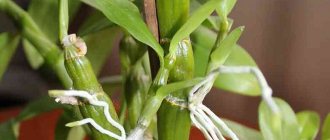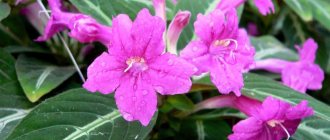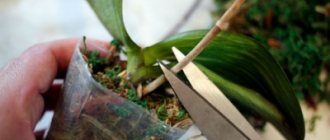Garlands of elegantly blooming bougainvillea vines are picturesque and incredibly colorful. Perhaps that is why, at the very first acquaintance with the overseas beauty, Russians, not spoiled by the extreme riot of colors, instantly associate with the breathtakingly spectacular holiday - the Brazilian carnival. That's right! Your associative thinking did not fail, since the birthplace of the festive bougainvillea is the distant and mysterious South American country of Brazil. Many of our flower growers have successfully mastered the secrets of growing exotic plants. However, they still look warily towards the temptingly spectacular bougainvillea plant, the cultivation of which would be another step for them on the path to realizing their dreams. And this dream is a man-made creation in your home of unearthly beauty and a festive atmosphere.
The Europeans named the ornamental flowering plant, which was striking in its novelty, after the French traveler Comte de Bougainville. In common parlance, the heroine of our story is called a “paper flower” due to the similarity of the bracts to crumpled colored paper.
The tropical flower surprisingly quickly took root in the European climate. Bougainvillea has won one of the most honorable places in the flower beds and gardens of hospitable Europe. Nowadays, the exotic beauty of bougainvillea is more often found outdoors, while breeders have taken the trouble to grow hybrids for indoor use.
Our article will serve as a road map for growing bougainvillea at home for Russian daredevils who have decided to acquire a tropical miracle at home. A short guide will guide beginners and experienced gardeners in a sea of questions about how to care for bougainvillea.
Biological description
Before we begin to understand the intricacies and nuances of the courtship procedure, let’s take a closer look at the plant and its progenitor.
Bougainvillea (Bougainvillea) is a member of the Nyctaginaceae or Nocturnal family. Contains 15 species, of which only a few are adapted for indoor conditions, most of them are Brazilian species. In its natural habitat, it is an evergreen climbing shrub or tree, the climbing branches of which can reach 5 meters in length.
The woody, thorny stems of the plant are equipped with short, sparse thorns for traction with support. Indoor hybrids, if you are too lazy to prune regularly, can imperceptibly transform into impenetrable thickets on your window.
The plant owes its popularity to its long flowering period: from spring to late autumn. Bougainvillea, which has safely acclimatized in Russian conditions, will delight the eye with its blooming outfit for 9 months in a row! Surprisingly, the compact flowers are completely modest and invisible against the backdrop of defiantly bright bracts, which have raised the decorative value of the plant among members of the family.
The bracts of various shapes and colors reach 6 cm in diameter. Together, they form a dense dome that overshadows the leaves and branches of the tree in the literal and figurative sense of the word. Breeders work tirelessly to create new hybrid varieties with the most incredible colors and shades. Classics of the genre - pink, red and purple bracts. Unlike faded flowers that quickly fade, bracts remain fresh and attractive for a very long time.
The narrow, smooth leaves of the plant are not of particular value. They are hidden from prying eyes for most of the year behind the undeniably dominant flowers.
One of the latest achievements of breeders was a variety with bracts of two colors. The scientists' real highlight was bougainvillea, a chameleon that changes color during the flowering season.
Description of the variety
Bougainvillea is a vine with a well-developed powerful stem reaching a length of more than five meters. The leaves are bright dark green, hard, and may have a smooth or slightly pubescent surface. The flowers are small in size, pale yellowish-cream in color, collected in racemes.
The bracts are of particular interest. These are three leaves that are brightly colored and resemble the texture of crumpled parchment paper. That is why the plant is often called a “paper” flower. Under natural conditions, the bracts have a crimson or purple color. Currently, many hybrid varieties have been developed with bracts of orange, bright red, white and pink.
In warm countries, the flower pleases with continuous flowering and does not have a dormant period, but it is not able to withstand temperatures below +5 ° C.
Basic rules for success
The well-known secrets of longevity, long flowering and health of the beautiful indoor bougainvillea when caring for it at home are the correct ones:
- temperature - warm in summer, cool in winter;
- lighting is the brightest possible;
- watering - plentiful in the spring-summer season, minimal in winter (the lump of earth should be almost dry);
- air humidity - in a heated room, the foliage cover must be sprayed;
- transplantation - if necessary, in early spring;
- propagation by stem cuttings, layering and seeds.
Problems during cultivation
Flower growers often wonder why bougainvillea doesn’t bloom or sheds its leaves at home? In most cases, the main reason is violation of agricultural practices. With a lack of light and nutritional supplements, as well as with an excess of moisture, the wonderful Brazilian plant refuses to bloom.
- Yellowing of leaf blades occurs when the soil is overly wet and water stagnates in the dishes. If there is an excess of moisture, the roots also rot and the plant dies.
- The bracts lose their rich color and turn green - this means the plant does not have enough light and nutrients. In summer, place the pot in the sunniest place, and in winter, add additional lighting using artificial lighting (fluorescent lamps, phytolamps).
- If the plant stubbornly does not want to bloom, try putting it in a stressful state - transplant it into a cramped container and water it less often.
- Bougainvillea may respond poorly to some fertilizers, so when using a new fertilizer, start in smaller doses than recommended in the instructions.
- If the leaf blade turns yellow but the veins remain green, there is likely a lack of nutrients, particularly iron.
In winter, the plant may shed some of its leaves and this is considered normal. Even if bougainvillea loses all its leaves, do not rush to throw it away! If you provide the flower with regular watering, a sufficient amount of heat and light, most likely it will quickly recover and produce many new shoots.
As for pests, bougainvilleas are practically immune to their attacks. Occasionally, aphids and mealybugs may appear, which are controlled with insecticides.
Care
Under normal indoor conditions, growing bougainvillea is difficult without specific knowledge and basic skills in floriculture. A “paper flower” in conditions unusual for its nature needs due attention to itself, monitoring the dynamics of development and simply a positive attitude.
Let us reveal an important secret to beginners in floriculture. It consists in the fact that you should not disturb the plant by moving it to a new place. The logical conclusion is that you should carefully approach the issue of choosing a place for the permanent location of bougainvillea even at the time of purchase. No matter how ideal the care, the flower is at risk of simply withering when moved. Take advantage of the opportunity to place the pot on a window facing south. Here the tropical plant will enjoy the abundance of light and warmth, almost like in its homeland. If this is not possible, a west window would be a good option. Air circulation will be useful, but without cold drafts. It is also undesirable to disturb the shoots, directing them at your own discretion. It will be much safer to form a crown using pruning.
Knowing some key points, you can begin a fascinating walk through the pages of our article, dwelling in detail on each of the mentioned rules for caring for bougainvillea.
Pruning bougainvillea
The beauty of the flower is that regular pruning of the branches allows you to grow a bush of any shape. The main thing is to show imagination and avoid mistakes when pruning the plant.
It is better to start trimming the stems in February. In this way, you can direct the forces of the flower in the right direction, that is, into the growth of a lush crown and the formation of buds. After pruning, the length of the new growth should not exceed 7 centimeters.
Note: you can distinguish an old stem from a new one by the thickness and degree of woodiness.
Old side shoots that slow down the growth and flowering of bougainvillea can be cut off completely. If there are young shoots, you can leave one leaf. When pruning the main branches, it is important to leave one leaf and one leaf bud.
Temperature
The heat-loving “Paper Flower” is surrounded by comfort in summer if the temperature varies between 23 - 30°C. This amount of heat best stimulates flowering. In hot times, the plant will appreciate a long stay in the fresh air or at least sufficient ventilation.
In a heated residential room, bougainvillea will not be able to get a full rest even once a year, since the start for it to go into rest is the descent of the column on the thermometer scale below 16°C. It is difficult to achieve this value in an apartment, especially in one where children live. That is why the bush continues to bloom on the windowsill all year round, which can weaken it. Concerned about replenishing the strength of their pet, flower growers tend to place bougainvillea for winter rest in an unheated loggia or on the balcony. Here, a cool winter at a temperature of 12 to 16 degrees will create conditions for the plant to lay a large number of flower buds. This measure will lead to effective lush flowering by the spring season. However, even here you need to be on alert so as not to let the temperature drop below the critical temperature. Already 7°C can be disastrous for the Nyctaginaceae family!
It is important to eliminate the possibility of sudden temperature fluctuations so as not to jeopardize the health of your homegrown beauty. If the balance of heat optimal for flowering in summer has not been established, the bracts will not be able to acquire the inherent brightness of color and delight their admirers.
bougainvillea bonsai
You can make a tree from Bougainvillea with one stem and several branches, in the form of a bonsai. How to do it:
- Leave two or three selected branches on the plant, cut off the rest.
- This species is maintained for quite a long time until the plant becomes lignified.
- Then the central branches are radically pruned into a stump.
- They are waiting for Bougainvillea to produce new shoots - they should also be controlled in growth: remove the excess ones, pinch and trim the long ones, correct them with wire if they deviate from the desired direction.
- When the branches become woody in the desired position, the wire is removed.
We remind you that bonsai are formed before the dormant period begins, so that Bougainvillea has time to produce new shoots and lay flower buds on them. Then, next spring, your mini-tree will delight you with bright and lush flowering.
Sometimes bare branches at the bottom of a bonsai look unsightly. We recommend that you graft cuttings onto bald branches. To do this, cut a young green cutting from the crown of the flower and remove all the leaves from it. Just be careful not to damage the kidneys. Select a location on the branch for grafting. Take a drill with a suitable size drill bit, drill a hole and insert the handle into it. Treat the vaccination site with medical glue. Soon the grafting will take root, and the bonsai tree will take on a more elegant appearance.
Insert the cutting into the hole in such a way as not to damage the buds, especially the one closest to the trunk. In the future, water the plant in a timely manner, do not move or disturb it, so as not to accidentally disturb the position of the grafted branches.
Often, on the contrary, bougainvilleas are used to make beautiful “flower waterfalls”, allowing the flower to grow long, flowing shoots. These shoots can be directed upward by tying them in time to supports: for example, specially installed trellises.
Lighting
The ability to choose the right place with optimal natural light, and, if necessary, adjust the value with artificial light is a task equivalent to balancing the temperature regime for indoor plants. It happens that those who “tamed a pet”, being irresponsible about the issue of light, simply ruined the plant, without waiting for the dream of the charm of a flowering tree to come true.
For the intensive development of bougainvillea, it is extremely important to provide bright light. It is one of the few plant species whose life directly depends on the amount of sunlight. For this purpose, choose the sunniest place for the flower, ideally a south-facing window sill. You should know that during daylight hours, bougainvillea should receive plenty of sunbathing for at least 5 hours. You should not be afraid of the scorching rays of the midday sun and getting burns. The South American ultraviolet lover will fully grow, develop and amaze the imagination of mankind with the brightness of the colors of the bracts only when she is given plenty of light. Poor lighting will inevitably lead to stretched stems, faded green foliage and a cessation of flowering.
However, there are nuances in the topic of bougainvillea lighting, depending on the time of year and periods of flower activity. It will need the maximum amount of light from the very first month of spring until October, that is, for the flowering period. During its well-deserved rest, during the winter dormancy period, the plant will feel comfortable in a place shaded from sunlight.
Common reasons among novice gardeners
Lack of sun
This is the main reason for the lack of flowering. In order for bougainvillea to bloom, it needs at least 5 hours of bright light a day. A lack of light may be indicated by elongated and thin new shoots of the plant.
How to help the plant: provide the necessary amount of light. For bougainvillea, south, south-east and south-west windows are recommended. But if you provide bougainvillea with a sufficient amount of sun, do not expect flowering right away; the plant needs to lay flower stalks, after which the first bracts will appear. It usually takes several weeks to several months before the plant is ready to flower. Much depends on the condition and variety of the plant.
Some varieties are capable of blooming under artificial light, but for bougainvillea, natural lighting is preferable, although if you want to get winter flowering, you can install backlighting with lamps.
Big pot
Do not plant a small plant in a large pot. A large amount of soil with an insufficiently developed root system can lead to waterlogging and death of the plant, and a small bougainvillea is unlikely to bloom in a large pot. The plant will first of all strive to grow its root system, spread out in the pot, and only then will it be ready to produce its first flowers.
How to help the plant: replanting into a larger pot should only be done when the roots reach the bottom and begin to emerge from the holes. At the same time, you cannot sharply increase the size of the pot; the diameter of the new one should be only 2-4 cm larger than the old one. After transplantation, you shouldn’t wait too long for flowering either; the plant needs to adapt to new conditions.
Variety
At the moment, bougainvillea has a large number of varieties that differ not only in the color and shape of the bracts, but also in the characteristics of growth and development. These features also affect the speed of their flowering. There are varieties of bougainvillea that bloom very quickly and willingly even in not the most favorable conditions. And there are varieties that are happy to increase their leaf mass, grow confidently and strongly, but even in the brightest sun they do not want to bloom. Such a plant can be identified by having several other bougainvilleas at home of approximately the same age. If all the plants on the windowsill are already blooming, and perhaps have bloomed several times, but this plant still stubbornly does not want to bloom, then this is a slow-flowering variety.
How to help the plant: be patient, these varieties need more time to prepare for flowering. To speed up flowering, you should place it in the most illuminated place. But you shouldn’t expect quick results; bougainvillea will definitely delight you with lush and beautiful flowering, but only when you are ready for it.
Cold wintering, is it necessary?
In the natural conditions of Brazil, where this plant originally lived, in winter the night temperature can drop to 10-15 C, while the daytime temperature rises above 20 C. We can say that in many regions of Russia, summer is as warm as the Brazilian winter.
Therefore, it is impossible to clearly say what conditions are necessary for wintering bougainvillea. But from our experience we can say that the presence of a cold winter does not in any way affect the formation of bracts and further flowering. Even in room conditions at temperatures above 25 C and in the presence of sufficient lighting, bougainvillea blooms in winter and blooms even more beautifully in spring and summer.
The need for a cold winter or creating a dormant period depends only on your desire and the conditions in which the plants are kept. Cold wintering in a dark place reduces the need to care for the plant and helps when there is not enough storage space in a heated room. But if you do not have the opportunity or desire to create special conditions, then there is no need for a cold winter.
Lack of flowering for an unknown reason
If you cannot determine the reason why bougainvillea does not bloom, then you can resort to the method used by some gardeners. For a short period of time, bougainvilleas are sharply limited in feeding and watering, which is carried out when the earthen ball dries out sufficiently. After some time, bracts appear on the plant.
Watering
The watering regime for bougainvillea is directly related to periods of activity. In spring and summer, during the period of intensive growth, the plant is watered abundantly. To avoid mistakes, test the soil mixture: it should be slightly moistened all the time, but not soggy. You should start watering immediately after the top layer of the earthen ball has dried at least halfway. By average, watering is carried out 1-2 times a week.
Water is poured into the pot until it seeps through the holes in the bottom.
It is important to remember the natural living conditions of the flower. In its natural environment, it grows on rocky areas of soil, where stagnation of moisture is simply impossible. Therefore, a moisture-loving home bush should not experience waterlogging of the substrate. You need to help him in this matter by draining excess moisture from the pan.
When autumn comes, the volume and frequency of watering is reduced, which helps prepare the bush for a period of rest and recuperation. From November until spring, bougainvillea is watered rarely and sparingly. At the same time, it is important to prevent the earthen ball in the pot from drying out completely. Average watering frequency at this time of year: once every 2-3 weeks. If the room is warm, then you need to water it a little more often. It happens that in winter the bush sheds its leaves completely. This will be your cue to stop watering until the dormant season is over. For irrigation use settled tap water.
Bougainvillea species
Bougainvillea is a fancy climbing plant of which there are 14 South American species. Previously bred species have stems with thorny thorns, while new ones have stems without thorns or with small, safe thorns.
Today there are many hybrids with small, inconspicuous flowers surrounded by amazingly beautiful bracts that look like colored crumpled paper, for which in some countries the flower is called a paper flower. The photo of Bougainvillea shows the variety of its color palette.
The most common types of Bougainvillea are:
- naked (low smooth). A thornless vine can reach up to 5 meters and is found in the form of low-growing bushes with a straight stem. The leaves are smooth, have richly colored bracts, bloom vigorously and for a long time. The shape of the bush is given by pruning;
- wonderful (beautiful), which grows on rocky slopes. The stem, petioles, and leaf edges are pubescent. It grows quickly and can reach up to 9 meters;
- Peruvian, which was first introduced in 1810. It differs from other species in its green bark, the leaves are long without edges, and the thorns are short and straight. Blooms 2-3 times a year. The flowers are yellow and the crown of leaves is pink or purple;
- "Faith". A beautiful flower with crimson bracts that change color to pink when blooming;
- "Mini Thai" It has a small evergreen bush that can be grown at home. The originality of the species lies in its variegation.
Varieties of the “miracle flower” differ from each other in:
- form. They can be terry, simple, triangular, oval;
- size of bracts;
- color of flowers, bracts and leaves. Some varieties have multi-colored bracts, others have variegated leaves. There are varieties whose bracts change their color.
Air humidity
Like any subtropical crop, bougainvillea prefers high air humidity, even when in a Moscow apartment. Regular spraying of the plant with soft water that has stood for at least 2 hours will help create conditions close to tropical ones. Therefore, take the trouble to arm yourself with a spray gun.
During flowering, the air is humidified selectively in the area of the bush, preventing droplets from falling on the surface of the bracts. During the dormant period, feel free to irrigate the inner and outer surfaces of the leaves for the benefit of the entire plant.
To create optimal air humidity, you can use other well-known methods, for example, an electric humidifier. It will be effective to place a pot with a flower on a tray with moistened pebbles or expanded clay. You can place a vessel under the bush, for example, a glass brazier filled with water. Remember that the larger the water surface area, the higher the humidity level can be achieved.
All efforts to ensure comfort will benefit your pet and will turn out to be a treat for the eyes.
Types and varieties, photos
The plant is widespread, but there are 4 species that are most familiar to professional gardeners, namely:
- B. wonderful. One of the most popular species, which has velvety leaves and large bracts that turn pale as they bloom. In southern countries, this species is widely used for decorating gazebos. In our latitudes it is used for loggias and balconies located on the sunny side.
- B. ordinary. A very beautiful species with glossy leaves and gorgeous bracts. Professional flower growers plant several of these plants in pots to create one of the most incredible compositions. It is worth noting that it is this species that is most often found in gardeners’ homes.
- B. Peruvian. The plant is distinguished by thin leaves, short spines and wrinkled bracts. This shrub blooms longer when compared with its relatives. The main advantage is that it does not require regular pruning. These hybrids were created by nature as lush and branchy. When the bracts open, the first tone is coppery, followed by a purple or pink tint. This type is recommended for purchasing at home. Because the flowering will last for a long time. And every guest, having seen such a miracle, will want to buy it for himself.
- B. Butt. A hybrid of Peruvian shrubs that gave rise to all modern varieties. The history of the plant is quite unusual. This hybrid was created by nature, and was accidentally discovered in one woman’s garden. Today, this type of plant bears the name of its discoverer, Mrs. Butt.
B. naked (Bougainvillea_glabra)
B. wonderful
B. yellow
B. peruviana
There are a large number of different varieties in the world. Breeders have worked to create many varieties, such as:
- lavender;
- fuchsia;
- snow-white;
- lilac;
- orange;
- yellow;
- pink - red.
In addition to the colors, the exotic beauty can have variety with double, variegated and color-changing bracts. Recently, new varieties of this beloved plant have been regularly appearing, and it is very difficult to keep track of the growth in their number.
Transfer
With the arrival of spring, the dormant stage comes to an end and the bush begins active growth. The green mass, roots and shoots grow intensively. At this very moment in early spring, it is recommended to replant bougainvillea.
Young “pets” grow rapidly. In close to ideal greenhouse conditions, the height of the bush increases to 3 meters in one year. It is noteworthy that in a spacious container your flower will grow long stems and branches. A cramped pot will provoke extremely lush flowering, while the height of the bush will change only slightly. At a young age, the plant is replanted annually. Thus, the proper level of nutritional value of the soil mixture is achieved.
An adult bougainvillea can hardly tolerate the worries associated with the transplantation procedure. It can get sick, lose its leaves and stop flowering altogether. Therefore, mature plants are replanted every 3-4 years. In this case, they prefer the method of transferring it into a container with a large diameter and try to avoid injury to the root system. It is important to check whether the root collar is buried in order to correct the situation in time.
The free gap that appears between the earthen lump and the walls of the pot is filled with new soil and only slightly pressed down, without compacting, but also without leaving voids. The bush is watered and placed for several days of rest in a shaded corner. After the roots have settled into their new home, the flower is returned to its usual place.
The weighty lashes of an adult plant along with flowers are quite heavy and need support. Bamboo or other strong supports are installed in the pot. To properly form a young bush, you will also need to install a bracket in the pot or stick a special ladder into the substrate.
Compliance with the rules for using the following three attributes of transplantation will allow you to carry out the process safely, and the flower will easily survive stress and quickly adapt.
- Pot. It is better to choose a deep pot that allows roots to develop. Mistakenly, some beginners prefer choosing an overly large flowerpot. According to the rules, the diameter of each subsequent container should exceed the previous one by the thickness of two fingers, about 3 cm. Too large a volume provokes stagnation of moisture and rotting of the roots, which is difficult to combat. When replanting into the previous container, wash it thoroughly and disinfect it. Shorten the roots enough to make them more comfortable.
- Drainage. Under natural conditions, bougainvillea grows on rocky soils. At the bottom of the pot, it will definitely need a generous layer of drainage: expanded clay, crushed stone or broken red brick.
- Priming. For a luxurious Brazilian beauty, prefer a store-bought special substrate. If this is not possible, you can make your own mixture of sand, compost, turf and leaf soil in a ratio of 1:1:2:2.
Features of care with photos
First of all, you need to take into account that indoor bougainvillea is a heat-loving flower that loves a lot of sunlight. It does not require shading even during midday hours, since it is absolutely not afraid of exposure to sunlight, which is detrimental to many other plants. Flowers do not respond well to frequent movements from place to place. Drafts are also extremely undesirable.
With the required amount of light, the flower actively grows and lays buds. During the flowering period, growth slows down greatly. In good weather, every day bougainvillea pleases with new flowers with bright bracts. Afterwards, a period of vegetative growth begins again.
It is recommended to keep the vine in a pot, or better yet, in a clay pot with a volume of up to 5 liters or in hanging flower pots. For a young bush, a container of 1-2 liters is sufficient.
The soil substrate must be fertile and loose. Bark, peat, and perlite are added to turf and leaf soils. Holes are made in the bottom of the container, and a good drainage layer of coarse sand or pebbles is laid.
Lighting
In the house for a flower you need to choose a well-lit place, so it is better to place the pot on the windowsills of the southern and south-eastern windows. In the spring-summer period, it is better to take the pot outside or to a balcony or loggia so that the plant is fully illuminated by the sun's rays, but at the same time protect it from drafts and gusts of wind. In winter, it is also important to provide adequate lighting. During the day, the plant needs at least 6 hours of intense light.
Hybrids with lilac and red bracts, as well as white species of bougainvillea, are sensitive to low temperatures, so with the onset of cold weather it is better to bring flowers from the balcony or from the street indoors.
Watering
It should be regular: abundant in summer and moderate in winter. During warm periods, the soil should always remain moist; during cool periods, it can be almost dry. Although the substrate should not be allowed to completely dry out. Withering and loss of turgor of leaves is a signal of lack of moisture. Well-settled water with a minimum lime content is used.
The plant loves high air humidity and needs frequent spraying, regardless of the season, especially if the plant is kept in heated rooms in winter. After spraying, the flower is noticeably transformed.
Temperature
The flower does not tolerate sudden temperature changes. Indoor species die at temperatures below 5-7°C. The optimal temperature in summer is from 20 to 32°C. In winter, it is necessary to ensure a fairly cool temperature regime (10-15°C).
If you keep the vine at room temperature all winter, this may negatively affect flowering. An insulated loggia is ideal for wintering.
Fertilizer
Fertilizing is carried out once every 7-10 days with phosphorus-containing fertilizers. It is better not to get carried away with nitrogen fertilizing. They stimulate the growth of green mass, which in turn inhibits flowering. The priority is to feed the plant in small portions, but often. At the same time, you should never exceed the dose, as this can kill bougainvillea. Organic fertilizers can be used periodically. To avoid burning the root system, all fertilizers are applied after watering.
Trimming
Under natural conditions, bougainvilleas reach a height of 5 m or more, clinging to other plants with their thorns and trying to reach the upper tiers illuminated by the sun. In apartments and winter gardens, flower growers usually regulate growth and trim stems. As a result, the flower can be grown not only as a vine, but also to form a compact bush or a low standard tree.
You can prune bushes several times during the growing season. In the spring, shoots that have grown over the winter are cut off, but each should have 5-7 internodes. For good flowering, it is enough to leave stems 35-50 cm long. In the summer, light formative pruning is periodically carried out to give the desired size and shape.
In autumn, more severe pruning is carried out - 50% of the young growth is removed, the ends are cut off, and perennial shoots are pinched. This procedure promotes growth and increases the abundance of the next flowering. Old, dry and damaged parts of the plant are removed as necessary.
Lianas require the installation of a support along which growing shoots are guided and formed. When growing a trunk, only the central stem is left, which is tied to a support, and after reaching the desired height, long shoots are cut off and a crown is formed.
The flower reaches its main peak of decorativeness in the 5th year of life.
Reproduction
Propagation of bougainvillea, now cultivated indoors, is possible in three ways:
- stem cuttings;
- rooting of air layering;
- seeds.
Considering the growing interest of Russians in bougainvillea and its propagation at home, we will dwell on each of them in more detail.
The cutting method is the easiest and most efficient. Cuttings are prepared at the very beginning of summer, choosing shoots that by this time have become half lignified. It is important not to spoil the mother plant, so non-flowering shoots or those that thicken the crown are cut off. The foliage of the lower part of the cutting is removed. The cut site is sprinkled with charcoal powder for disinfection, and then with any of the root formation stimulants, for example, root.
For rooting, the cuttings are planted in a mixture of peat and sand in a container and covered with a lid or film. It is important to keep the soil mixture warm with the thermometer at 25-26 degrees and always moist. The greenhouse should be located in a well-lit place. For successful rooting, it is better to provide bottom heating and artificial lighting. Ventilating the cuttings periodically is as important as watering to maintain moisture. Watch. As soon as you notice that the cutting has begun to grow, you should open the greenhouse. By the end of 2 months, roots will appear. It's time to delicately replant the plant into a pot no higher than 10 cm, filled with soil from a mixture of peat, sand, compost and leaf soil.
Next, the young plant is grown in a cool, bright place with a temperature of approximately 20°C. Pinching is carried out for the purpose of branching at the moment when the length of the shoot reaches 5 cm.
After the pot is completely filled with the root system, the bush is transplanted into a pot of a larger diameter, about 12 cm. You should not forget to place a generous layer of drainage on the bottom, which will prevent stagnation of liquid in case of waterlogging.
Propagation of bougainvillea by cuttings at home is possible even in winter. During winter cuttings, cutting is carried out in February-March. The main thing is that the selected shoot has 2-3 buds. The lower leaves are removed completely, and the upper ones are cut in half to reduce the area of moisture evaporation. The cuttings are placed in a container with a dissolved root growth stimulator for a day, and then rooted according to the same scheme as the summer ones.
You can try propagating bougainvillea by cuttings in a glass of water. In order for the long-awaited roots to finally appear, you will have to provide a humidity of about 80%.
The good thing about the air layering method is that it can be done at any time of the year. It's done like this. A small container is filled with a moist substrate and placed next to the mother plant in the place where a young shoot has been selected that has retained its flexibility and has not yet become lignified. An incision or scratch is made on the bark of this shoot to stimulate the formation of roots. The shoot is bent to the soil and firmly secured with the cut section. Noticing that rooting went well, separate the sprout from the parent bush and plant it in its own pot. Vegetative propagation will take about 30 days. The grown plant is replanted, pinched and trimmed. By next season we can hope for the appearance of a flower ovary.
The third method is not popular among gardeners. Seed propagation is too long, difficult and often ineffective. It involves the pollination of flowers, which in nature are carried out by butterflies and miniature hummingbirds - residents of tropical regions. Artificial pollination is too troublesome.
You can buy seed material in a specialized store, but to obtain seedlings you will have to sacrifice a lot of effort and waiting time.
Bougainvillea does not bloom, what should I do?
Sometimes, bougainvillea lovers may notice that their favorite plant does not bloom. This change could be caused by the following:
- The plant was moved from open air to a room, and there was a sharp change in location and temperature.
- The flower was just purchased in a store and has not yet had time to adapt to the new environment.
- There has been a seasonal change in temperature indicators.
- Transplanting the plant into a larger pot. As soon as the root grows, the flower will bloom.
- Incorrectly organized period of rest or its absence at all. The plant needs to be given rest.
- Cool and rainy weather in summer. You need to remove the bush from a damp and cool place.
When all recommendations for growing are followed, the flower quickly adapts to new living conditions and soon begins to delight all household members with flowering.
Top dressing
Feeding bougainvillea is a must! Especially during the activation of growth and flowering, the plant needs to receive nutrients at least once every 2 weeks. Flower growers with experience of communicating with the “Brazilian girlfriend” recommend using fertilizers of organic and mineral origin, specifically designed for ornamental flowering plants. During the dormant period, feeding should be stopped.
When choosing fertilizers, pay special attention to the fact that nitrogen compounds stimulate growth, while potassium and phosphate compounds stimulate flowering.
Bougainvillea care
Bougainvillea belongs to the genus of evergreen ornamental flowering shrubs of the Nyctaginaceae family. The plant is also called paper flower.
Bougainvillea is a native of Brazil, but its name is French. Thanks to the navigator from France Louis Antoine de Bougainville, he was able to discover this exotic beauty. Today, there are approximately 14 types of flowers in nature. The domesticated bougainvillea is a flower with French charm and Brazilian temperament. It is unlikely that this plant can leave at least one person indifferent.
A fence, patio or arch decorated with bougainvillea branches looks amazingly original.
Homeland and appearance of bougainvillea
Under natural conditions, the flower can be found in the hot and humid tropics of Brazil. The plant can take the form of a tree, but it is predominantly a shrub, the branches of which, reaching five meters in length, stretch along the support. The stems of the vine become woody over time. A distinctive feature of the plant is its thorns. The leaves have a smooth surface, oval and slightly pointed shape. Grow along the entire length of the stem.
The flowers of the plant are small and yellow. The bracts, which are very brightly colored, look the most decorative and attractive. Some novice gardeners confuse them with flower petals. The color of the inflorescences is bright crimson. You can also purchase hybrid varieties of bougainvillea with white and red inflorescences.
For growing at home, bougainvillea smooth is used - a low-growing plant with a compact shape. Despite the fact that bougainvillea is grown in gardens, it is primarily a houseplant or greenhouse plant. This beauty can be grown in any place where the air temperature throughout the year does not fall below +5 degrees.
Watering mode
During the period of growth and flowering, bougainvillea must be watered abundantly, but between waterings the soil should dry out a few centimeters. It is important to avoid both stagnation of water and overdrying of the earthen clod. If the plant does not receive enough water, the buds begin to fall off.
During the dormant period, watering is reduced, but care is taken to ensure that the soil does not become too dry.
Note: it is necessary to water the bush with settled water, the temperature of which is from +20 to +25 degrees. There should be no chlorine in the water.
Lighting requirements
Bougainvillea feels best in conditions of bright, but diffused light. You can also plant shrubs in partial shade. This lighting regime is necessary for the plant throughout spring and summer. During the dormant period, the shrub needs five hours of daylight.
To grow bougainvillea at home, choose south or west windows. Be sure to take the flowerpot with shrubs out into the fresh air so that the plant receives a sufficient amount of oxygen and sunlight. Note: it is necessary to protect the plant from direct sunlight, as this can lead to leaf burn.
Temperature
The optimal temperature for bougainvillea is considered to be within +22-+30 degrees. During the rest period, the temperature must be reduced to +5-+7 degrees. This rather extreme air temperature provokes the shedding of leaves, but this is a natural process due to which the shrub is covered with new, fresh leaves and flowers the following spring. Note: temperatures below +4 degrees lead to the death of the plant.
Air humidity
In summer, on hot days, bougainvillea must be sprayed regularly. It is better to carry out water procedures in the morning, so that by the evening the flower has time to dry well.
Feeding and fertilizer
From spring to autumn, it is necessary to fertilize the soil every two weeks. Nitrogen and phosphorus fertilizers are used as top dressing.
During the dormant period, the plant does not need additional nutrition.
Trimming
Myths that the Brazilian “paper flower” is capricious, apparently, are based on a lack of knowledge and basic skills in plant formation. Meanwhile, pruning bougainvillea at home is one of the mandatory stages of indoor maintenance. By neglecting this procedure out of ignorance or lack of experience, you doom the plant to stop growing and flowering. Hence the lack of faith in one’s strength as a florist and the collapse of hopes. Let's fill the knowledge gap!
Several prunings are carried out per year. The time before spring awakening and on the eve of winter dormancy is good for this. In the spring, the shoots of last year are shortened by half, weakened, dried out and injured branches are removed. A correctly carried out procedure will mark the beginning of wild flowering. In late autumn, shoots should be trimmed to one third of the length, leaving 6-8 buds on each. At the same time, mature branches of three years of age are not touched, so as not to injure the bush unnecessarily.
In the active phase of growth and flowering, the purpose of pruning shoots is to maintain the aesthetic appearance of the bush. Inflorescences that have lost their visual appeal are cut off. The haircut is done above the bud or leaf. It is better to remove shoots that are weak or directed inward to the crown altogether. To stimulate the growth of side branches, which will bloom in lush colors in the same season, faded shoots are promptly removed.
In the autumn season, formative pruning will be successful. You can make your fantasies come true. You can give the plant the appearance of a multi-stemmed bush. By leaving several vine-like vines unpruned and strengthening them on a figured frame, you can achieve any bizarre shape of the bush. The main thing is not to forget to leave the current season's buds on the stem to be sure of the plant's renewal.
Bougainvillea species cultivated indoors are perfectly formed by pruning into a dwarf bonsai tree. Such a specimen will decorate the interior of the house, delight the owners and surprise the guests.
Pruning in spring and autumn
In spring and autumn, radical anti-aging pruning is carried out. Remove some of the old, woody shoots and shorten the remaining ones by half.
- Begin pruning by cutting off any dead, damaged or diseased parts of the bougainvillea.
- Remove large, intrusive branches and any branches that have been deformed during the bougainvillea pruning process.
- Step back to inspect the bougainvillea and continue pruning to achieve the desired shape.
In the future, even during the summer, do not forget to carry out cosmetic pruning by pinching the tips of the shoots. Repeat pruning as needed, or every 4 to 6 weeks during the growing season, to encourage new flowers to form.
Bougainvillea is a very useful material for forming any kind of crown. Craftsmen even create chic bonsais with thick, fancy trunks from this flower. You will never say that in front of you, in essence, is a liana!
In the intervals between regular pruning, carry out the so-called pinching, tearing off the wilted tops of the inflorescences with your fingers. Fertilize your bougainvillea after trimming a lot of branches to replenish the plant's strength.
Pests and diseases
Tropical bougainvillea is already by birthright endowed with resistance to attacks by pests and diseases. The main thing is to provide complete care and concern for maintaining the natural immunity of the plant.
However, it is recommended to regularly inspect the flower for parasites. Quite rarely, but an attack on a plant by a spider mite, aphid or mealybug occurs. Well-known insect control methods, including insecticide treatment, will help. It’s great if you managed to preserve the aesthetic appeal of the plant. Only timely action will protect pets from exhaustion and even death.
As a rule, uninvited bloodthirsty insects settle in the house with the arrival of new green guests. As a preventive measure, it is necessary to make it a rule that a two-week quarantine is required for each new flower.
A symptom of powdery mildew disease is the appearance of a whitish coating on the leaves. If action is not taken immediately, the plaque will turn brown. You will need to remove the affected areas, dust them with sulfur and treat them with special preparations.
With chlorosis, the leaves turn pale and yellow, and white spots appear on the surface of the leaf blade.
The appearance of rot on the roots is not a death sentence! Bougainvillea needs to be saved. To do this, free the root system from the soil and inspect it, cutting out the affected roots. The remaining healthy roots must be temporarily dipped in a solution of life-saving phytosporin. Irrigate the foliage of the plant with part of the solution. Disinfect the cut areas by dusting with crushed wood ash. At the end of the treatment, plant the bush in fresh nutritious soil and give caring care.
Throw away imaginary fears and self-doubt! Knowing the secrets of keeping bougainvillea at home, you can easily realize the dream of creating a garden of Eden in your home and find a new friend in the person of the magnificent beauty of the tub plant - the Brazilian queen of the carnival.
| Growing | The brightest lighting possible. Summer warmth (23 - 30°C), winter coolness (12 - 16°C). Watering is plentiful in warm weather and minimal in cold weather. Regular ventilation |
| Humidity | In a heated room, it is recommended to spray the leaves with soft water, avoiding contact with the bracts, or place them on a tray with moistened expanded clay. |
| Feeding and pruning | Fertilize once a week during the active phase of growth and flowering. Health and formative pruning several times a year |
| Flowering period | At home - at any time, but it is better to ensure peace from November to February inclusive |
| Landing, transplant | Planting in a pot with substrate. Transplantation in early spring. Young plants - annually. Mature - once every 3-4 years by transshipment |
| Reproduction | Stem cuttings, rooting of air layering, rarely by seeds |
| Pests | Spider mites, mealybugs, aphids |
| Diseases | Powdery mildew, root rot, chlorosis |
Bougainvillea diseases
A tropical flower like bougainvillea is highly resistant to diseases. But if you care for her incorrectly, her immunity will weaken.
The leaves are falling
The leafing of a healthy bush shortly before the start of the dormant period is a completely natural process. If the leaves fall at a different time, then there may be several reasons for this: the flower was exposed to a draft, it was turned the other side towards the window, or it was moved to a new place.
A recently purchased plant may also lose leaves. In this case, the discharge of greenery is associated with a move, which causes stress in the plant. If the bush has begun to become bare, then try to provide it with the most comfortable conditions for growth and proper care; in this case, very soon it will acquire lush foliage and begin to bloom.
A bush can also shed its leaves when you move it to fresh air in the summer and bring it into the house with the onset of autumn. And even if you simply move the plant to another place where there is less light, this can also cause the leaf blades to fly around.
The foliage has faded
If the color of the foliage has become faded, this may be a sign that the bush is suffering from chlorosis. As a rule, a plant is affected by it when the substrate contains too little iron and other nutrients. Feed the flower as soon as possible and spray its foliage with an iron chelate solution.
Spots on leaves
If soft white spots have formed on the surface of the leaf plates, this indicates that there is constant stagnation of liquid in the soil mixture, and the room is poorly ventilated. In this case, the room must be regularly ventilated, and watering must be reduced to moderate. All foliage with spots is torn off.
Yellowing and leaf loss
This may be due to excessively abundant watering, due to which the substrate begins to sour and the root system lacks oxygen. As a rule, this problem occurs in winter. In this case, the flower should be watered less often and less water should be used, and also stop fertilizing and moistening the foliage for a while. It will be very good if he “goes into hibernation” for a while.
The bush has become lethargic
If the bush has lost its turgor, it is recommended to treat it with a solution of a product that stimulates growth. Next, cover it on top with a bag and put it in a shaded place for 2-3 days, but do not forget to systematically ventilate it.
Growth has stopped
If you notice that the bush has stopped growing, this may indicate that it is in an overly cramped container, while the root system has nowhere to grow further. In this case, the flower will need to be transplanted into a larger container.
A very old bush (more than ten years old) may also stop growing. It becomes woody and does not form inflorescences. Experts advise, in this case, to propagate bougainvillea in a timely manner.
Root rot
If rot appears on the roots, then you can try to save the bougainvillea. Remove it from the container and carefully remove the soil mixture from the root system. If this is necessary, then first immerse the roots in a container of warm water, and then remove all the soil from them. Then inspect the roots and cut out any rotten or damaged ones. The remaining roots must be kept for some time in a solution of Fitosporin, and the foliage of the plant is also sprayed with it. After this, all cut areas are sprinkled with wood ash or charcoal powder. Then the bush is planted in fresh soil mixture and given good care.
Pests
It is extremely rare for sucking pests to settle on bougainvillea. This can be understood if a mealy coating (mealybug) or cobwebs (spider mites) appear on the foliage, and the leaves may become sticky and faded (aphids). To clean the bush from pests, you can resort to folk remedies, namely: give the plant a warm shower, use an infusion of wood ash or garlic, and you can also use a solution of laundry soap for spraying. However, if there are a lot of pests, then it is better to immediately spray the bush with a special insecticide, which can be bought in a specialized store, for example: Aktellik, Aktara or Fitoverm. To accurately get rid of harmful insects, you will need at least 2 treatments. Before you start spraying the flower, you must carefully study the instructions included with the product.
Bougainvillea - the main thing you need to know to get started.
Care errors and their elimination
Problems when growing bougainvillea and methods for eliminating them:
| Problem | Causes | Solution |
| Falling leaves | Drafts, change of location, temperature changes | Choose a permanent place for the flowerpot, do not move it unnecessarily, avoid drafts and sudden changes in air temperature in the room |
| Fading leaves | Lack of nutrients, poor lighting | Regularly fertilize, spray with iron, place the plant in a well-lit place |
| Brown spots on leaves | Keeping in a cold room with high humidity | Maintain a high level of humidity if the room temperature is not lower than +20-25 degrees; during the dormant period, reduce watering and spraying |
| Drying and deformation of leaves and bracts | Dry indoor air, insufficient watering | Remove the flowerpot from heating appliances, regularly humidify the air, and water the flower |
| Stopping growth | Very cramped pot, plant age more than 10 years | Transplant into a larger container, propagate bougainvillea in a timely manner |
